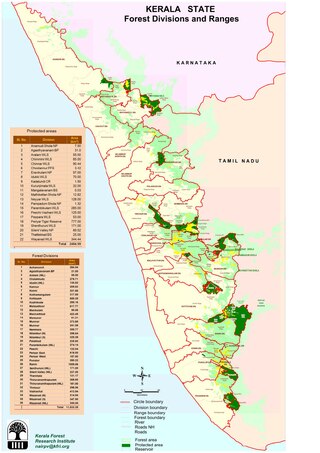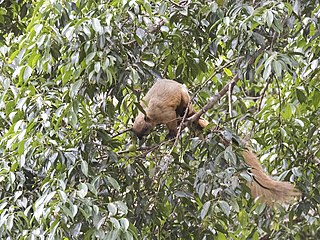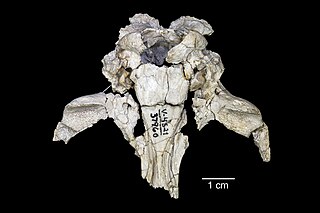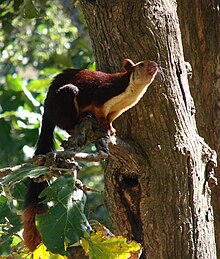
Squirrels are members of the family Sciuridae, a family that includes small or medium-sized rodents. The squirrel family includes tree squirrels, ground squirrels, and flying squirrels. Squirrels are indigenous to the Americas, Eurasia, and Africa, and were introduced by humans to Australia. The earliest known fossilized squirrels date from the Eocene epoch, and among other living rodent families, the squirrels are most closely related to the mountain beaver and dormice.

Struthionidae is a family of flightless birds, containing the extant ostriches and their extinct relatives. The two extant species of ostrich are the common ostrich and Somali ostrich, both in the genus Struthio, which also contains several species known from Holocene fossils such as the Asian ostrich. The common ostrich is the more widespread of the two living species, and is the largest living bird species. The extinct genus Pachystruthio from the Late Pliocene-Early Pleistocene of Eurasia is one of the largest birds ever.

Flying squirrels are a tribe of 50 species of squirrels in the family Sciuridae. Despite their name, they are not in fact capable of full flight in the same way as birds or bats, but they are able to glide from one tree to another with the aid of a patagium, a furred skin membrane that stretches from wrist to ankle. Their long tails also provide stability as they glide. Anatomically they are very similar to other squirrels with a number of adaptations to suit their lifestyle; their limb bones are longer and their hand bones, foot bones, and distal vertebrae are shorter. Flying squirrels are able to steer and exert control over their glide path with their limbs and tail.

Eutamias is a genus of chipmunks within the tribe Marmotini of the squirrel family. It includes a single living species, the Siberian chipmunk. The genus is often treated as a subgenus of Tamias, which is now restricted to the eastern chipmunk of North America. Neotamias, which now includes the western North American chipmunks, has also been included in Eutamias.

Tree squirrels are the members of the squirrel family (Sciuridae) commonly just referred to as "squirrels". They include more than 100 arboreal species native to all continents except Antarctica and Oceania.

Sri Venkateswara National Park is a national park and biosphere reserve in Tirupati in Andhra Pradesh, India. The total area of the park is 353 km2. The park is known for its many waterfalls, including the Talakona, Gundalakona and Gunjana. As the Government of India declared the Seshachalam Hills as one of the biosphere reserves of India in 2010, this national park becomes the part of it.

The Indian giant squirrel or Malabar giant squirrel is a large multi-coloured tree squirrel species endemic to forests and woodlands in India. It is a diurnal, arboreal, and mainly herbivorous squirrel.

Most of Kerala's native habitat, which consists of wet evergreen rainforests at lower elevations and highland deciduous and semi-evergreen forests in the east, has a humid tropical climate. However, significant variations in terrain and elevation lead to high biodiversity. But Alappuzha district has no forests.

Amphicyon is an extinct genus of large carnivorans belonging to the family Amphicyonidae, subfamily Amphicyoninae, from the Miocene epoch. Members of this family received their vernacular name for possessing bear-like and dog-like features. They ranged over North America, Europe, Asia, and Africa.
Bhimashankar Wildlife Sanctuary was created in the Ambegaon and Khed talukas of Pune District, in the Western Indian state of Maharashtra in order mainly to protect the habitat of the Indian Giant Squirrel.

Sciurini is a tribe that includes about forty species of squirrels, mostly from the Americas. It includes five living genera—the American dwarf squirrels, Microsciurus; the Bornean Rheithrosciurus; the widespread American and Eurasian tree squirrels of the genus Sciurus, which includes some of the best known squirrel species; the Central American Syntheosciurus; and the American pine squirrels, Tamiasciurus. Like other arboreal squirrels, they are sometimes referred to as tree squirrels.
La Venta is a fossil locality located in the modern departments of Tolima and Huila in Colombia. This site is one of the richest Neogene fossil assemblages in South America and represents the best-known Cenozoic fossil site outside of Argentina. It provides a glimpse of what life in the region was like before the main wave of the Great American Interchange.

The Grizzled Squirrel Wildlife Sanctuary (GSWS), also known as Srivilliputhur Wildlife Sanctuary, was established in 1988 to protect the Near threatened grizzled giant squirrel. Occupying an area of 485.2 km2, it is bordered on the southwest by the Periyar Tiger Reserve and is one of the best preserved forests south of the Palghat Gap.

The cream-coloured giant squirrel or pale giant squirrel is a large tree squirrel in the genus Ratufa found in forests in the Thai-Malay Peninsula, Sumatra (Indonesia), Borneo and nearby small islands. The species is near threatened and vulnerable to habitat degradation, and it has probably been extirpated in Singapore where the last sighting was in 1995. Reported sightings in Vietnam in 1984 are considered to be dubious.

The black giant squirrel or Malayan giant squirrel is a large tree squirrel in the genus Ratufa native to the Indomalayan zootope. It is found in forests from northern Bangladesh, northeast India, eastern Nepal, Bhutan, southern China, Myanmar, Laos, Thailand, West Malaysia, Cambodia, Vietnam, and western Indonesia.
Lagrivea is a fossil genus of squirrel from the Middle Miocene of France. The single species, L. vireti, is known from three mandibles and two isolated teeth. All come from the fissure filling of La Grive L5, part of the La Grive-Saint-Alban complex in Saint-Alban-de-Roche, southeastern France. Lagrivea was a large tree squirrel with flat lower incisors and a large, triangular fourth lower premolar (p4). Each of the four cheekteeth bears a deep basin in the middle of the crown. The m3 is about rectangular in shape, but rounded at the back. Although m1 and m2 have two roots, m3 has three.
Miopetaurista is an extinct genus of flying squirrel. Fossils of this genus have been found from the Miocene and Pliocene of Europe Asia (China), and North America (Florida).

Hondadelphys is an extinct genus of carnivorous sparassodonts, known from the Middle Miocene of Colombia. The type species, H. fieldsi, was described in 1976 from the fossil locality of La Venta, which hosts fossils from the Villavieja Formation. Hondadelphys was originally interpreted as belonging to the opossum family Didelphidae, but subsequently assigned to its own family, Hondadelphidae and interpreted as a basal sparassodont. The genus name refers to the Honda Group, the stratigraphic group in which the fossils of this animal were first found, combined with delphys (Greek for "womb", a common suffix used for opossum-like metatherians).
Squirrel poaching includes any poaching of any squirrel.



















